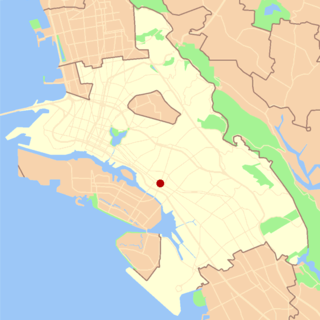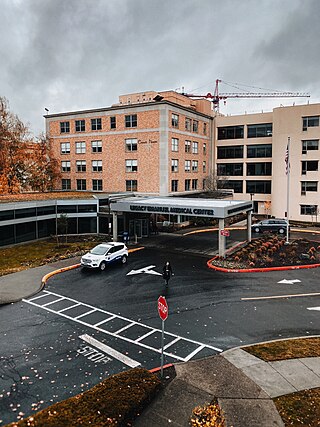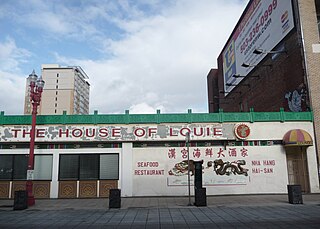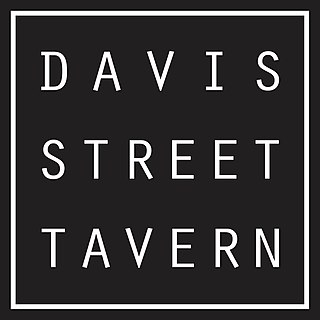
Interstate 405 (I-405), also known as the Stadium Freeway No. 61, is a short north–south Interstate Highway in Portland, Oregon. It forms a loop that travels around the west side of Downtown Portland, between two junctions with I-5 on the Willamette River near the Marquam Bridge to the south and Fremont Bridge to the north.

Fruitvale is a neighborhood in Oakland, California, United States. It is located approximately 4 miles (6.44 km) southeast of Downtown, and is home to the city's largest Hispanic population, with Hispanics constituting 53.8% of Fruitvale's population. Fruitvale's ZIP code is 94601. It lies at an elevation of 49 feet.

Old Town Chinatown is the official Chinatown of the northwest section of Portland, Oregon. The Willamette River forms its eastern boundary, separating it from the Lloyd District and the Kerns and Buckman neighborhoods. It includes the Portland Skidmore/Old Town Historic District and the Portland New Chinatown/Japantown Historic District, which are listed on the National Register of Historic Places. It has been referred to as the "skid row" of Portland.

Alberta Arts District is a commercial district in Portland, Oregon which connects the Concordia, King and Vernon neighborhoods in the Northeast quadrant of the city. The district centers on NE Alberta Street, and stretches approximately 1.5 miles (2.4 km), from Martin Luther King Jr. Boulevard to NE 33rd Avenue.

Oak Park is a neighborhood in Sacramento, California. The McGeorge School of Law, University of the Pacific Sacramento Campus, Sacramento High School, and Christian Brothers High School are located in this neighborhood.

Legacy Emanuel Medical Center is a hospital located in the Eliot neighborhood of Portland, Oregon, United States. Founded in 1912, it is one of only two Level I trauma centers in the state of Oregon, and home to the only burn center between Seattle and Sacramento. The hospital is also home to the Life Flight Network (MEDEVAC), the first of its kind instituted on the U.S. West Coast. The 554-bed facility provides a full range of services, including conventional surgery, heart treatment, critical care, neurology/stroke care/brain surgery, and care for high-risk pregnancies. Legacy Emanuel also houses the Randall Children's Hospital. It is one of the hospitals in the area where gun shot victims are routinely brought in.

The Rinehart Building, located in the Eliot neighborhood in north Portland, Oregon, is listed on the National Register of Historic Places. The two-story brick building was constructed in 1910 and is one of the last remaining structures from the historic Albina neighborhood.

North Williams Avenue is a north–south street located in Portland, Oregon, United States, and it defines the eastern boundary of North Portland. North Williams Avenue stretches from its southern terminus at Northeast Winning Way, near the Moda Center, to its northern terminus at North Winchell Street, a distance of 3.3 miles (5.3 km). It is a street common to the Portland neighborhoods Eliot, Boise, Humboldt, and Piedmont.

Backspace was a coffee shop, gallery, Internet café, and all-ages music venue located in the Old Town Chinatown neighborhood of Portland, Oregon, in the United States. The venue opened in mid 2003 and closed in 2013.

Hung Far Low was a Chinese restaurant in Portland, Oregon's Old Town Chinatown neighborhood, in the United States.

The Jade District is an Asian-dominated commercial area and cultural hub radiating outward from Southeast 82nd Avenue and Division Street, in Portland, Oregon, in the United States. It is roughly between Division Street and Powell Boulevard to the north and south, and between SE 75th Avenue and I-205 to the east and west. Part of the Montavilla, Powellhurst-Gilbert, and South Tabor neighborhoods, the district is one of the most diverse census tracts in the state of Oregon.

House of Louie was a Chinese restaurant in Portland, Oregon's Old Town Chinatown neighborhood, in the United States. The restaurant was managed by James Leung, as of 2006, and closed in 2018 after operating for 30 years. In 2023, the building which housed the restaurant was purchased by the nonprofit organization Sisters of the Road. The group plans to use the building for offices and a cafe, opening in June 2025.

Mother's Bistro and Bar is a restaurant in Portland, Oregon.

The H. C. Keck House, also known as the Mount Olivet Parsonage, is a historic building located in the Eliot neighborhood of Portland, Oregon, United States. Built in 1899 by German American carpenter Henry C. Keck, it illustrates the settlement of Albina by ethnic Europeans and is a good example of the use of the Queen Anne style in that period. As the presence of African Americans in Albina increased, the house was purchased by Mount Olivet Baptist Church in 1929 to be its parsonage. In that role, the house was home to locally prominent civil rights leaders Rev. Jonathan L. Caston and Rev. J. James Clow.

Davis Street Tavern was a restaurant in Portland, Oregon's Old Town Chinatown neighborhood. Christopher Handford, chef Gabriel Kapustka, and Handford's cousin Blake Smith opened the restaurant serving American cuisine in 2008. The building that housed it was previously a bakery. Kapustka left in 2010, after being bought out by partners. Subsequent executive chefs were Scott Shampine and Katy Jane Millard. The restaurant hosted an annual supper celebrating Robert Burns. In 2012, Davis Street Tavern and the Oregon Restaurant and Lodging Association led an effort by industry groups to overturn the U.S. Department of Labor's rules prohibiting gratuity sharing with kitchen staff. The restaurant closed in September 2016.

Bridges Cafe & Catering was a restaurant and catering service in Portland, Oregon. Established in 1994, the cafe was later purchased by Tom and Laura Lane-Ruckman, who continued to operate the business until the economic impact of the COVID-19 pandemic forced a closure in November 2020. The restaurant served Southern and Tex-Mex cuisine and had earned more than half of its revenue from catering. Considered a neighborhood favorite, the interior featured a small dining room, mosaic tiled tables, and artworks by various artists on the walls depicting bridges. The cafe was most known for its grits, its longtime server called "Phreddie", and for supporting local groups.

Tilt was a hamburger restaurant with multiple locations in Portland, Oregon, United States.
Allen Ervin Flowers was the first African-American developer in Portland, Oregon and a pioneer.

Dean's Beauty Salon and Barber Shop is a historic business and commercial building located in the Eliot neighborhood of Portland, Oregon, United States. Organized in 1954 and purpose-built in 1956, it is one of the relatively few Black-owned businesses to survive the upheavals of urban renewal, disinvestment, and gentrification that decimated the Black business district in lower Albina starting in the 1960s. It represents the history of African American entrepreneurship in the Albina area and the importance of the hair care industry in African American culture, and became an important gathering place for the Black community. As of 2021, it is the oldest continuously operated Black-owned business in Oregon.

Tamale Boy is a Mexican restaurant chain with multiple locations in the Portland, Oregon metropolitan area, in the United States.


















